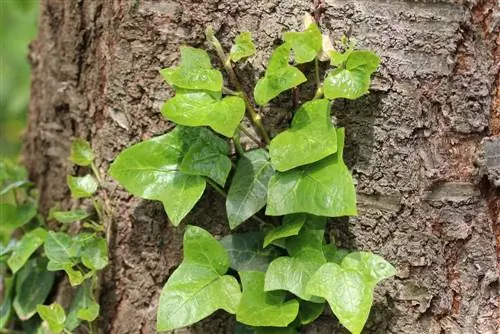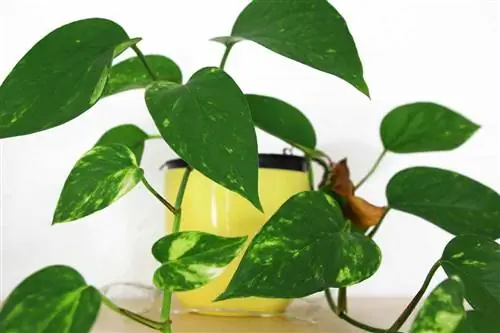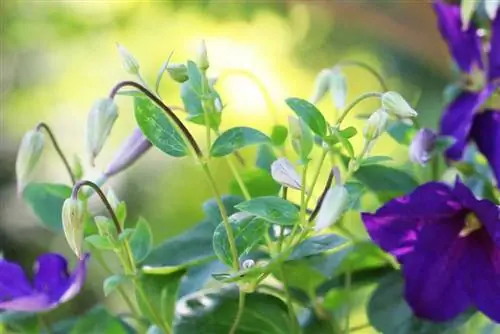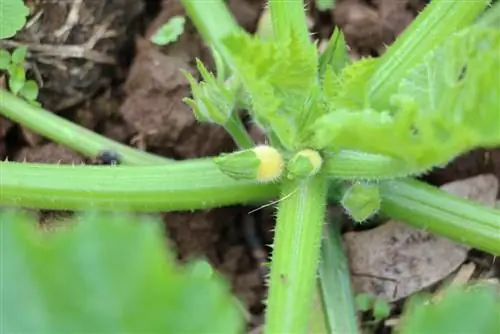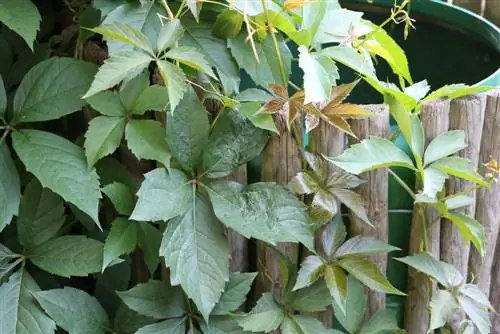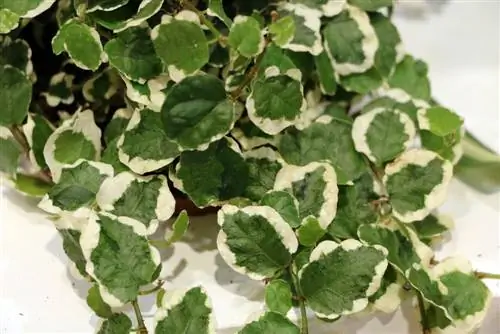- Author admin [email protected].
- Public 2023-12-17 03:39.
- Last modified 2025-01-24 12:45.
Climbing ivy is very popular due to its fast growth and low demands and is an easy-care plant in the garden. Whether on the facade of the house or as a ground cover in the natural garden, caring for climbing ivy is easy and does not require a lot of time if the gardener has chosen the right location.
Tips for planting
All types of climbing ivy come from ivy, which grows wild as a forest plant. For this reason, climbing ivy should be planted in a shady spot and prefers not to be exposed to full sunlight. The only exceptions here are those varieties that have colorful foliage and require 2 to 3 hours of sun per day to develop color. The low demands of the plants refer to:
- the shady, damp but not wet location
- a nutrient-rich soil that is preferably calcareous
- do not choose a color that is too bright and light-reflecting for the house wall
- Do not plant climbing ivy on fresh concrete walls.
Even if the conditions for beautiful growth can be met without difficulty, it is not uncommon for the climbing ivy to avoid the house wall and turn away. The plant can be found on any wall, so planting climbing ivy is not only an option on natural stone walls or wooden houses. However, the dark and shadow-loving ivy appreciates walls that are not too bright and reflect sunlight. Even in a newly built house with a concrete wall, the ivy will not climb up the wall in the first few years, as the high PH value causes it to turn away from the house wall and allow the climbing ivy to grow in other directions. Climbing ivy can be found in small pots at garden centers or hardware stores. With the right choice of location and nutrient-rich soil, the gardener will be surprised at how quickly the climbing plant grows and stretches up the wall.
Putting fast-growing climbing ivy in its place
As a fast-growing climbing plant, the climbing ivy spreads not only on the house wall, but also in a ground-covering form directly at its location. To prevent this, the plant should be pruned regularly. It is also important to check before planting whether the climbing ivy has enough space to spread or whether it would deprive other plants of space and nutrients as it grows. A house wall with climbing climbing ivy looks very harmonious, natural and serves as an eye-catcher on the property. However, the gardener should counteract the wild growth of the fast-growing climbing plant and thus avoid damaging the structure of the house. Pruning is necessary when the plant is:
- in cracks in the plaster
- on the window frames and windows
- in undesirable growth direction
- along the gutter
- up on the roof of the house
would like to rank. The climbing ivy could clog the gutter and form very strong roots in porous masonry and cracks in the plaster, thus allowing moisture to penetrate into the building structure. Furthermore, the strong roots in the masonry have the strength that would cause the cracks to widen and thus lead to consequential damage to the house. If the gardener takes this into account when caring for the climbing ivy and trims the tendrils according to the direction of growth, the fast-growing climbing plant will only provide a beautiful look and not damage the house.
The right cut for full growth
Climbing ivy can reach a height of up to 20 meters. However, it usually doesn't grow as densely and bushy as the gardener would like. Full growth can be achieved through regular pruning, which is best done in April for new shoots. To cut the fast-growing climbing plant, proceed as follows:
- Using sharp hedge trimmers
- Short the shoots by about 5 centimeters
- remove unwanted shoots just above the main trunk
- Cut shoots straight and above a leaf bud.
If the gardener allows the climbing ivy to grow freely, it will spread quickly and uncontrollably throughout the entire house. In doing so, it leaves out neither the windows nor the gutter and, instead of creating a beautiful greenery on the facade, it can result in damage to the masonry. When growing naturally, climbing ivy stretches upwards, so that it reaches an enormous height, but not the desired fullness. To promote this and achieve a completely covered facade in the desired areas, the pruning should be done generously and not too timidly.
Wintering
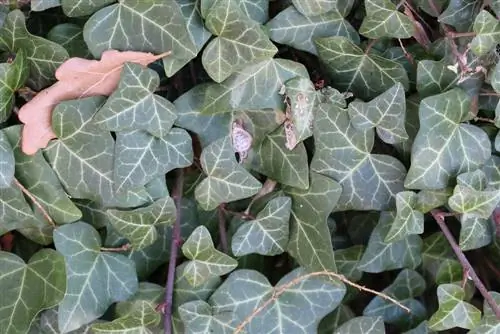
As a direct descendant of a forest plant, climbing ivy prefers a shady location all year round. In winter it is particularly important to protect the leaves from strong sunlight. Young plants in particular could be damaged by the winter sun and their sensitive leaves could practically burn. Preparing for winter involves these tasks:
- Removal of dead shoots
- Checking the main roots on the ground
- Removal of roots visible above ground
- Wrap the plant in light-tight fleece
- Cover root ball with bark mulch.
Prevent typical diseases
Even the robust climbing ivy is not immune to pests and fungal diseases. The gardener can detect a plant disease by checking it regularly. Eating spots on the leaves indicate a pest infestation, while light green or very small leaves covered with a cloudy layer indicate a fungal disease. Aphids are also not uncommon and can affect the fast and vigorous growth of the climbing plant. Here the soil substrate should be changed and the pests and traces on the leaves should be removed generously.
For a he althy, fast-growing climbing plant like ivy, it is important to adhere to its natural needs and to find an optimal location for the climbing plant. The climbing ivy is easy to care for; it is given a shady place in the garden and can grow in nutrient-rich, calcareous and moist soil. Waterlogging should be avoided as it would damage the roots of the plant and limit growth.
Notes on climbing ivy
With the help of climbing ivy, ugly walls and fences can be quickly covered. It serves as a privacy screen and can also be used as a natural roof over a pergola. The ivy grows quickly and can spread enormously. He often becomes a nuisance. In general, the growth capacity of ivy is underestimated.
If you want to remove it, the ivy's adhesive roots usually form an obstacle. They cannot be easily removed from the wall. There are fine root hairs on the adhesive roots. These push themselves into the pores of rock, stone and walls. So they sit tight like little dowels and it takes a lot of effort to remove all the remains.
General
- The formation of adhesive roots depends on the type of ivy.
- Adhesive roots only form once when sprouting.
- These adhesive roots adhere differently to different substrates and surface structures.
- Many adhesive roots are formed, especially in the shade.
Climbing Ivy Removal
Killing the plant
- It is best to cut the trunk.
- The plant is left in place for a few weeks until it has dried well. Young ivy plants that have many fresh roots are not removed when they are wet. There are too many residues left on the wall.
- The root should be dug up if possible, otherwise the ivy will sprout again. It regenerates even if everything above ground has been removed.
Expose facade
- When the ivy has withered, most of the young roots detach themselves from the substrate. Less residue remains.
- You can pull off the individual long shoots by jerking and pulling at the bottom end until the strand comes off.
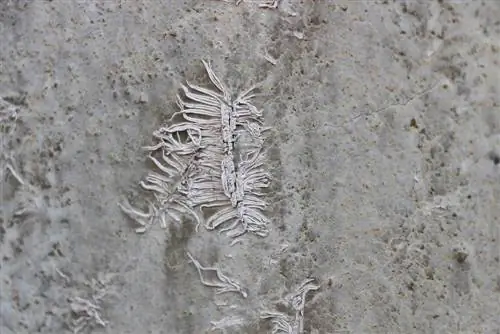
Removal of adhesive roots
- A large number of adherent roots often remain on the facade. It looks bad.
- The rougher and stronger the facade, the more difficult they are to remove.
- For difficult surfaces, scarfing is the best solution. Before the gas burner is used, all large plant residues must be removed so that a fire cannot occur.
- On plastered and/or painted facades, a high-pressure cleaner (hot water) is usually sufficient. Plastic cleaner in water helps with the job. If necessary, a wire brush must be used.
Renovate facade
- Usually at least one new coat of paint is necessary.
- The plaster often needs to be repaired.
Conclusion
All in all, removing climbing ivy is very time-consuming. Before you buy such a plant for greenery, you should find out exactly what can happen.

